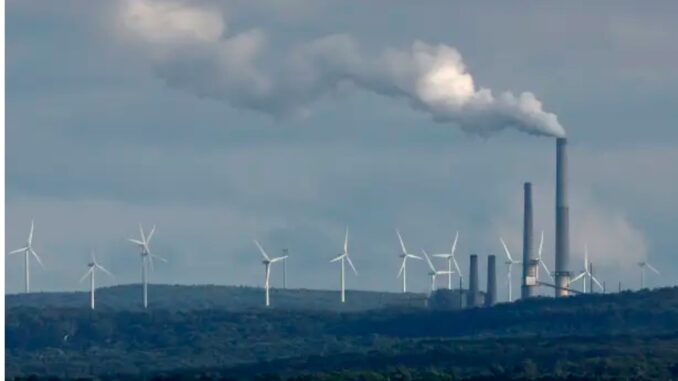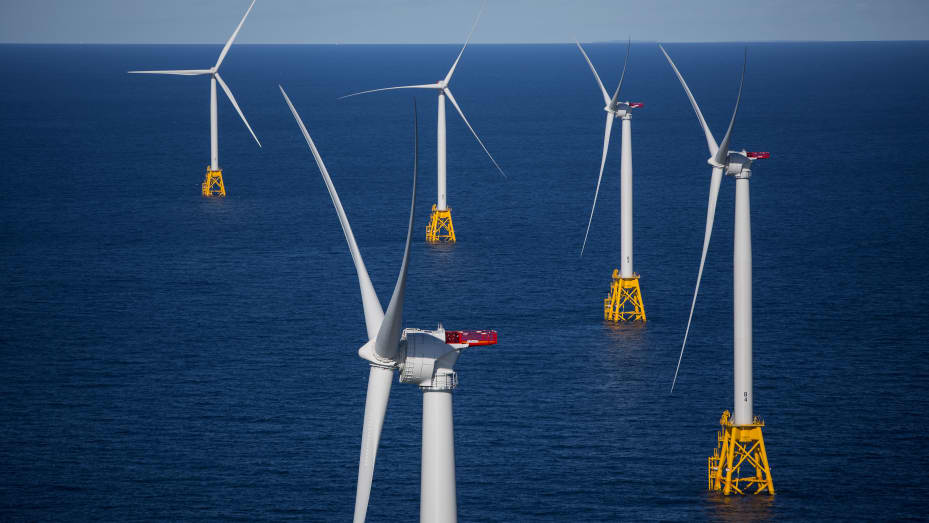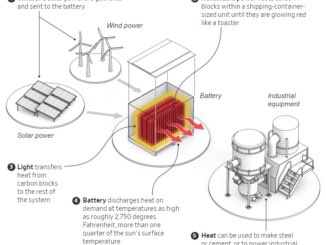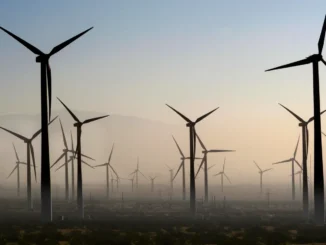
ENB Pub Note: Can the losses really happen if the regulations get in the way of the tax credits and the supply line controlled by China for over 75% of the materials? Throw the current administration into the mix, and it does not seem possible.
- Siemens lost nearly $1 billion on wind last year; pure-play Vestas saw an operating profit decline of 369%.
- The Inflation Reduction Act has renewable energy companies encouraged about the outlook and contemplating more wind manufacturing in the U.S., and the stakes are high: “To be crystal clear,” Siemens Energy CEO Christian Bruch told CNBC in November, “energy transition without wind energy does not work.”
It’s been a tough couple of years for the U.S. wind energy industry. Despite mounting pressure to combat climate change by transitioning to renewable sources, a confluence of factors disrupted supply chains and upended the economics of project financing. Rising inflation and interest rates, the war in Ukraine, and reduced tax incentives have plagued wind turbine manufacturers and developers of both land-based and offshore wind projects.
Nonetheless, today there’s an air of optimism within the industry, driven in large part by billions of dollars in new tax credits and subsidies toward clean energy investments included in the Biden administration’s Inflation Reduction Act. Although 2023 is expected to remain sluggish, GE Renewable Energy, Siemens Energy and Vestas Wind Systems, the leading makers of wind turbines — outside of China, which has built the world’s largest wind energy infrastructure — and their suppliers are banking on growth over the next decade, particularly in the nascent offshore wind niche.
Barr pointed to turbines that were sold to project developers back in the 2020-21 timeframe, when OEMs’ capital expenditures and pricing had been steadily declining. Then, over the last two years, as it came time to deliver the turbines, “the costs of raw materials, specialized logistics and labor skyrocketed through the roof, which has left those OEMs holding the bag on profitability,” Barr said.
And it’s a hefty bag. Last November, Siemens Gamesa (since absorbed into Siemens Energy) reported a net loss of more than $943.48 million for its fiscal year that ended September 30. In a November interview with CNBC’s “Squawk Box Europe,” CEO Christian Bruch said there were “challenges in wind,” especially when it came to supply chains.
In January, three months after GE announced it was laying off 20% of its U.S. onshore wind workforce, GE Renewable Energy posted a loss of $2.24 billion for 2022, compared to a decline of $795 million the previous year. Even so, CEO Larry Culp expressed a sanguine tone when speaking with analysts. “While the demand drop due to the [production tax credit] lapse significantly impacted our renewables results in 2022, the Inflation Reduction Act is a real game-changer for us and the industry going forward,” he said.
In early February, Vestas reported a 369% drop in operating profit for 2022, which it attributed to geopolitical uncertainty, high inflation and supply chain constraints. The turbine manufacturer recorded a EBIT loss of more than $1.2 billion last year, compared to about a $456 million gain in 2021.
For all of 2022, the industry installed 25.1 GW of renewables capacity, according to the ACP, marking a $35-billion capital investment — but that marked a 16% decline from the record year in 2021 and a 12% decline from 2020. Focusing solely on wind energy, there was a similar good news-bad news conundrum. Land-based wind ended 2022 with its strongest quarter, commissioning 4 GW of new projects. Even so, the ACP said, the total of 8.5 GW installed for the full year reflected a 37% year-over-year drop, mostly due to the declining value of the production tax credit, which expired for new projects at the end of 2021.
The IRA, however, reestablishes the PTC and offers other attractive incentives to the wind industry, and in total, it is estimated that the IRA will drive investment of nearly $369 billion in clean energy and climate priorities, according to the ACP. In an update released Monday morning, the trade group says that’s already taking place, in the form of more than $150 billion in capital investment for utility-scale clean energy projects and manufacturing facilities in the past nine months, more than was invested in total between 2017 and 2021. Since August, the new report noted, 48 renewable energy facilities have been launched, expanded or reopened, including 10 wind manufacturing facilities.
Wind manufacturing in the U.S. coming back
There are nearly 72,000 utility-scale wind turbines installed in the U.S., almost every one of them land-based, generating about 140 GW of energy or about 9% of the nation’s electricity. Many of them are produced by an increasingly complex domestic wind energy supply chain, steadily built up since the early 1980s, centered around turbine towers, blades and nacelles (housing atop towers that contain drivetrains), plus the myriad components required to assemble each one.
The industry’s supply chain disruptions resulted in reduced demand for new land-based turbine orders, forcing manufacturers to ramp down their operations, said Patrick Gilman, program manager for the U.S. Department of Energy’s Wind Energy Technologies Office. Yet those doldrums appear to be subsiding.
“Now that the IRA has passed and we have long-term policy certainty for basically the next decade, OEMs are either reopening or spinning back up mothballed factories, announcing new facilities and otherwise expanding production,” Gilman said, referring to the nation’s fairly mature land-based supply chain. Indeed, in early February, Siemens announced plans to reopen two turbine component factories that it had mothballed last year, adding that the IRA had sparked a pick up in demand.
Comparatively, the U.S. offshore wind industry is just ramping up after years of delays in permitting, environmental approvals and power purchasing agreements with utilities that buy wind energy. To help catapult the sector, in March 2021, the Biden administration set a goal of deploying 30 GW of offshore wind energy by 2030.
To date, there are only seven operational offshore wind turbines in the U.S., five off the coast of Block Island in Rhode Island and two off Virginia Beach, a Dominion Energy project that ultimately will feature 176 turbines. By comparison, elsewhere worldwide there were 246 offshore wind farms in operation at the end of last year — 134 in Asia and 112 in Europe — translating to 54.9 GW of energy spun from thousands of turbines, according to World Forum Offshore Wind.

There is currently one offshore wind farm under construction in the U.S., Vineyard Wind 1, 35 miles off the coast of Massachusetts. The project is jointly owned by Copenhagen Infrastructure Partners and Iberdrola, through a subsidiary of Avangrid Renewables, and GE will supply 62 Haliade-X turbines. With an estimated price tag of $3.5 billion, Vineyard Wind will begin generating power late this year, and when completed in 2024 will annually produce 800 MW of electricity. In the meantime, there are 17 other offshore wind projects on the East Coast in various stages of development.
GE’s turbines for Vineyard Wind, along with most of the project’s major components, are being exported from production facilities in Europe. Yet if that and other offshore wind farms are to meet the White House’s 2030 goal, it will require the rapid build-out of a U.S.-based manufacturing supply chain and at least $22.4 billion in investments between now and then, according to a report published in January by the National Renewable Energy Laboratory, the Business Network for Offshore Wind and other partners.
The supply chain would include building 34 new manufacturing facilities, including specialized ports and vessels. If individual states and companies leverage their existing manufacturing capabilities in sectors such as land-based wind energy, oil and gas, and shipbuilding, the report said, this effort would generate significant workforce and economic benefits throughout the country, not just in coastal locations.
In anticipation of the East Coast offshore projects gaining momentum, Vestas, Siemens and GE each recently announced plans to build new turbine component factories in New York and New Jersey, though contingent upon securing orders and receiving state and federal funding. And as the prospects of building wind farms in deep waters off Maine, New Hampshire, Gulf Coast states, California and Oregon — in which conventional fixed-bottom offshore turbines are not feasible — the federal government is coordinating with OEMs to develop floating offshore turbines.
Last fall, the Biden administration initiated the Floating Offshore Wind Shot, which seeks to reduce the cost of this emerging innovation by more than 70% and deploy 15 GW by 2035. “We see floating offshore wind as one of the clean energy technologies with the most upside potential for deployment in the coming decades,” said U.S. Secretary of Energy Jennifer M. Granholm at a related summit in February.
By and large, the U.S. wind energy industry is in good shape, if the short-term economic issues can be overcome. “It just has to get over this speed bump, most of which is driven by supply chain issues,” said Wood Mackenzie’s Barr. “If all the players involved can make it through the end of this year, we think the future is bright for the industry.”
The stakes are high. “To be crystal clear,” Bruch told CNBC back in November, “energy transition without wind energy does not work.”



